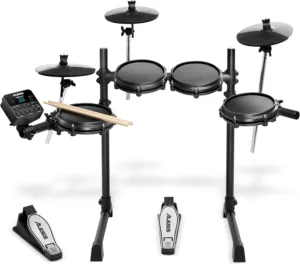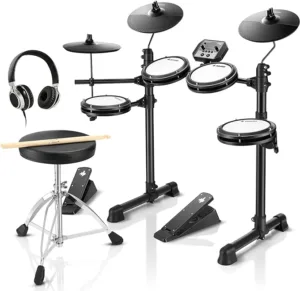The Dynamic World of Drum Pads: Unleashing Rhythmic Creativity
Introduction
In the realm of music production and performance, the drum pad has emerged as a dynamic tool that has revolutionized the way musicians and producers interact with rhythm. From the humble beginnings of acoustic drums to the technological marvels of electronic music, the drum pad has become an essential component in modern music-making. In this essay, we will explore the fascinating world of drum pads, delving into their history, evolution, functionality, and the impact they have had on music creation. By the end, you will gain a comprehensive understanding of why drum pads have become an integral part of the music production landscape.

The Evolution of Drum Pads
Drum pads trace their origins back to the invention of the drum itself, an instrument that has captivated humanity for centuries. From ancient civilizations to tribal communities, drums have served as a means of communication, expression, and celebration. As music evolved, so did the need for new ways to create percussive sounds. Enter the drum pad, a modern incarnation of this age-old instrument.
In the early 20th century, drum pads made their appearance as practice tools for drummers. These pads consisted of a rubber or synthetic surface mounted on a solid base, providing a more muted sound compared to traditional drums. Drummers would use these pads to hone their technique and improve their accuracy. Little did they know that these rudimentary practice tools would pave the way for an entirely new realm of musical possibilities.

The Rise of Electronic Drum Pads
The advent of electronic music in the mid-20th century brought about a seismic shift in the world of drumming. As technology advanced, drummers and musicians sought new ways to manipulate sound and explore uncharted sonic territories. Electronic drum pads emerged as the perfect conduit for this creative exploration.
Early electronic drum pads utilized pressure-sensitive surfaces, allowing drummers to trigger various sounds by striking the pad with their drumsticks. These drum pads were often connected to a synthesizer or drum module, which produced the desired sound based on the input from the pads. This breakthrough technology enabled drummers to experiment with a vast array of sounds and create unique rhythmic textures.

Drum Pads in Music Production
While drum pads were initially developed for drummers, they quickly found a home in the realm of music production. As producers and artists sought new ways to craft beats, drum pads provided an intuitive and tactile means to program and perform rhythm. With the advent of MIDI (Musical Instrument Digital Interface) technology, drum pads became even more versatile.
Modern drum pads are equipped with MIDI functionality, allowing seamless integration with software-based music production platforms. This integration empowers producers to trigger virtual instruments, samples, and drum sounds, expanding their creative palette. The ability to program beats, manipulate sound parameters, and perform live with drum pads has become a cornerstone of electronic music production.

The Versatility of Drum Pads
One of the key strengths of drum pads lies in their versatility. Unlike acoustic drums that produce a single sound, drum pads can trigger an infinite range of sounds and samples. This flexibility allows musicians to explore diverse genres, experiment with various sonic textures, and push the boundaries of rhythm.

Drum pads provide an avenue for expressive performance. By incorporating velocity sensitivity, where the force of the strike on the pad affects the sound's dynamics, drummers and producers can infuse their rhythms with nuance and emotion. This nuanced control over dynamics and articulation brings a human touch to electronic music, blurring the line between live performance and programmed beats.

Beyond Rhythm: The Creative Potential
While drum pads are synonymous with rhythm, they offer far more than just beats and percussion. Today's advanced drum pads incorporate features such as pressure sensitivity, aftertouch, and assignable controls,
opening up a world of creative possibilities.
These additional features allow musicians to go beyond traditional drumming and explore new avenues of expression.
Pressure sensitivity, also known as velocity sensitivity, detects the force applied to the drum pad and translates it into varying degrees of loudness or intensity. This feature enables musicians to add dynamics and subtle variations to their performances. By striking the pad softly, they can produce gentle, delicate sounds, while harder strikes result in powerful, impactful tones. This dynamic range adds depth and realism to the music, making it more engaging and emotionally resonant.
Aftertouch is another innovative feature found in advanced drum pads. It allows musicians to manipulate sound parameters after striking the pad. By applying additional pressure or shifting their fingers across the pad, they can modulate effects, change the pitch, or control other assignable parameters. This real-time control over sound manipulation adds a layer of expressiveness and enables performers to create evolving and dynamic compositions.
Assignable controls, such as knobs, sliders, and buttons, provide even more flexibility and customization options. These controls can be mapped to various parameters within music production software or hardware synthesizers, allowing musicians to tweak and shape their sounds on the fly. Whether it's adjusting filter cutoff, applying effects, or altering modulation parameters, the ability to assign controls to different functions empowers artists to sculpt their sonic landscapes with precision.
Drum pads also offer innovative sequencing and looping capabilities, further expanding their creative potential. Many modern drum pads come equipped with built-in sequencers, step-sequencing functionality, and loop recording features. These tools enable musicians to create complex rhythmic patterns, layer multiple sounds, and build entire compositions in real-time. With the ability to loop and overdub, artists can experiment with different ideas, gradually building up their tracks, and exploring new musical territories.
Moreover, the integration of drum pads with computer software has opened up a vast library of sounds and samples. Musicians can access a multitude of virtual instruments, drum kits, and sound libraries, expanding their sonic palette exponentially. This vast array of sounds allows for endless experimentation and enables artists to create unique sonic signatures that define their musical identity.
In live performances, drum pads bring a new level of energy and interaction. Drummers and electronic musicians can incorporate drum pads into their setup, providing an exciting visual element as they trigger sounds and perform intricate rhythms. The combination of traditional acoustic drums with electronic drum pads creates a fusion of organic and electronic elements, resulting in a dynamic and captivating live experience.
Conclusion
In conclusion, drum pads have revolutionized the music production and performance landscape, transcending their humble origins as practice tools for drummers. From their early beginnings as electronic drum triggers to their modern incarnation as versatile and expressive instruments, drum pads have become indispensable in the creation of contemporary music. With their versatility, dynamic control, and integration with music production software, drum pads have unlocked a world of rhythmic and sonic exploration. Musicians and producers can now delve into new genres, experiment with textures, and push the boundaries of rhythm and sound. Whether in the studio or on stage, drum pads continue to shape and define the ever-evolving landscape of music production and performance. So, embrace the dynamic world of drum pads and unleash your rhythmic creativity!



